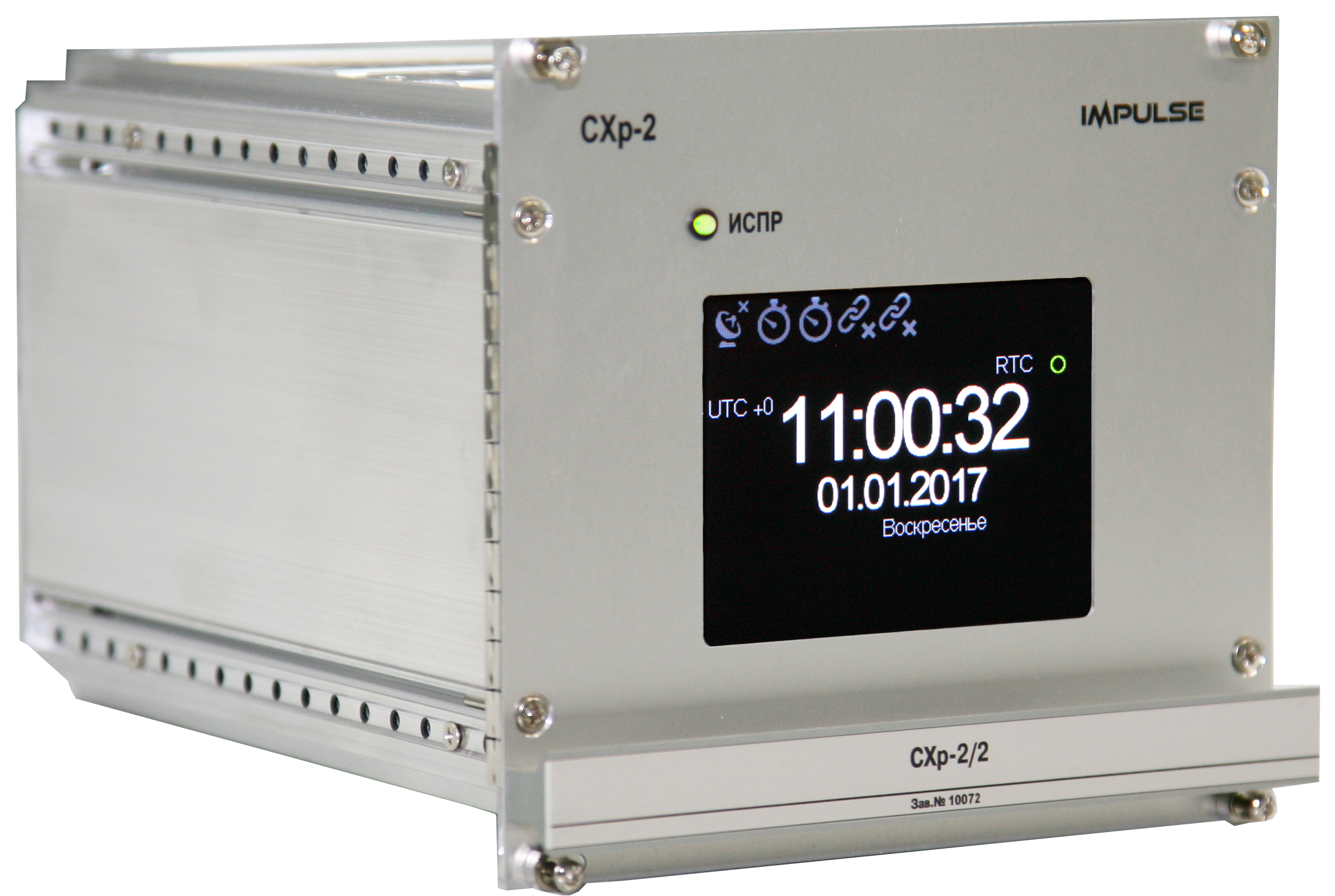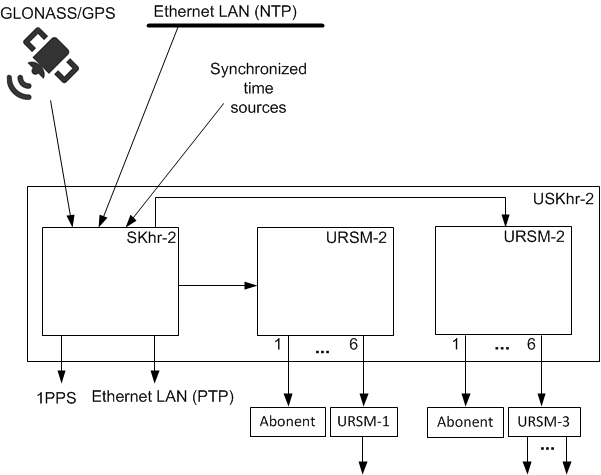
DEVICES OF THE UNIVERSAL TIME SYSTEM
|
Fields of use: universal time systems in I&C systems; automated systems for measuring, monitoring, signalling, control at power facilities; digital substations; other systems requiring high-precision universal time reference. The devices of the universal time system assure two variants of transmission of standard time signals:
|
 |
The devices of the universal time system:
- an SKhr-2 synchronometer;
- URSM-1, URSM-2, URSM-3 main signal amplifiers-retransmitters;
- an USKhr-2 synchronizing device (can contain SKhr-2, URSM-1, URSM-2, URSM-3).
Functions of SKhr-2:
- receiving time synchronization signals from:
- satellite navigation systems (SNS);
- an NTP server (RFC 1305) via an Ethernet network;
- two independent synchronized time sources;
- shaping and delivering standard time signals via communication links based on optical fiber;
- delivering second mark signals (1PPS) in the form of a TTL-compatible pulse;
- delivering messages via a 100Base-FX optical interface for time synchronization in an Ethernet network;
- time keeping in an autonomous mode (when there are no external sources of synchronization);
- displaying time, date, diagnostic information, as well as possibility to configure with the help of a touch screen;
- monitoring operability with generation of diagnostic messages into an Ethernet network;
- possibility to connect both single and redundant power supply.
Functions of USKhr-2:
- multiplying output signals of SKhr-2 with transmission via a fiber-optical communication link;
- converting optical signals into electric ones with transmission via “twisted pair” in accordance with the Ch7-43 synchronometer protocol;
- assuring connection of the main optical cable via an optical cross;
- providing uninterruptible power supply for SKhr-2 and auxiliary equipment (direct current with voltage 27±0.8 V with operation from a network and from 19 to 28 V with operation from a backup accumulator battery);
- monitoring operability and diagnosing component parts.
Functions of URSM-1, URSM-2, URSM-3 – amplifying and multiplying signals to build a branched universal time network, converting optical signals into electric ones with transmission via “twisted pair” in accordance with the Ch7-43 synchronometer protocol and backwards.
URSM-1 has:
- one input (optical or “twisted pair”);
- one optical output;
- two “twisted pair” outputs for mainline connection of up to 25 abonents.
URSM-2 has:
- one input (optical or “twisted pair”);
- six optical outputs
- one “twisted pair” output for mainline connection of up to 25 abonents.
URSM-3 has:
- four inputs (two optical ones and two “twisted pair” ones);
- two optical outputs;
- six “twisted pair” outputs for mainline connection of up to 75 abonents;
- automatic disconnection of synchronization from a faulty source;
- automatic time keeping when there is no connection with all sources.
One of arrangement variants for the universal time system based on USKhr-2, SKhr-2, URSM-1, URSM-2, URSM-3 is given in the figure.

Fig. 1. – One of versions of the universal time system
| № | Characteristic | Value |
| Metrological characteristics of SKhr-2 | ||
| 1 | Error of standard time signal shaping as related to UTC during synchronization from SNS, ms, not more than | ±1 |
| 2 | Accuracy of seconf mark signal delivery (1PPS), µs | ±1 per 1000 periods |
| 3 | Error of event affixing to the universal time of the system, ms, not worse than | ±2 |
| Characteristics of communication links | ||
| 4 | Distance of a receiving antenna from SKhr-2, m | up to 100 |
| 5 | Types of communication links | based on “twisted pair” or optical fiber |
| 6 | Length of communication links between amplifiers-retransmitters, m:
|
|
| 7 | Quantity of ports of SKhr-2:
|
|
| 8 | Type of connectors:
|
|
| Characteristics of power supply of SKhr-2 | ||
| 9 | Operating voltage (direct current), V | from 19 to 35 |
| 10 | Power consumption, W, not more than | 15 |
| 11 | Power supply channels | 2 |
| Characteristics of design | ||
| 12 | Overall dimensions, mm:
|
|
| 13 | Weight, kg, not more than:
|
|
| Conditions of operation | ||
| 14 | Ambient air temperature, °C | from +15 to + 50 |
| 15 | Relative air humidity, % | from 10 to 75 |
| 16 | Atmospheric pressure, kPa | from 86 to 108 |
